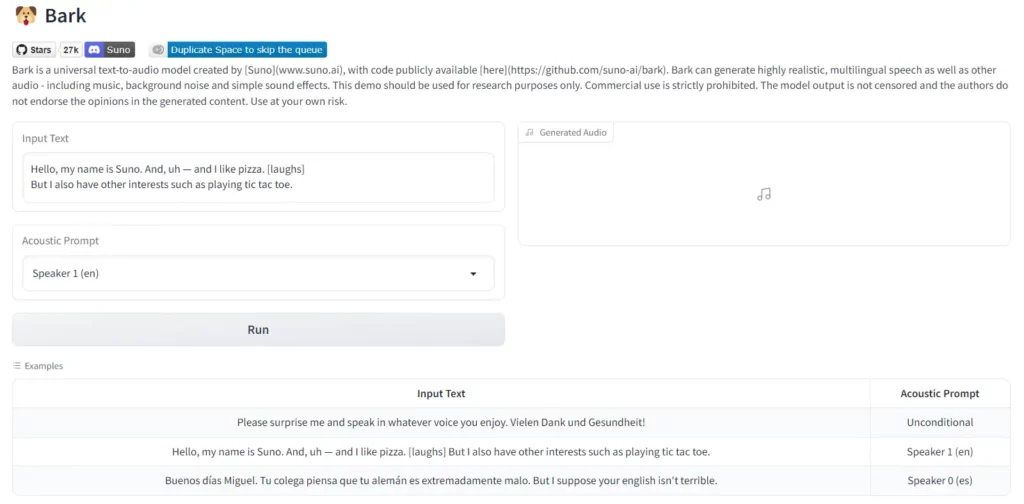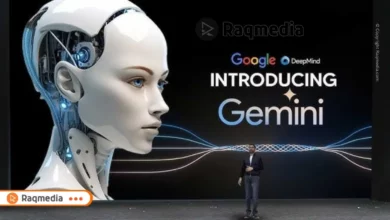Text-to-speech technology has become increasingly important in recent years, with the rise of audiobooks, podcasts, and other audio content. Bark AI is a free text-to-speech AI voice cloning software that has gained popularity for its natural-sounding voices and customizable options. In this Bark AI review, we will cover its features, benefits, limitations, use cases, and alternatives.
What is Bark AI and Text-to-Speech?
Bark AI is a cutting-edge artificial intelligence platform that offers an impressive text-to-speech capability. With the ability to convert written text into lifelike human-like voices, Bark AI allows users to bring their words to life in a more engaging and immersive way. Whether you're creating videos, presentations, podcasts, or any other form of content, Bark AI can seamlessly transform your written content into spoken words with stunning accuracy.

One of the standout features of Bark AI is its voice cloning capability. This means that users can actually train the AI model to sound like a specific person's voice. By providing it with just a few minutes of audio recordings from that person, Bark AI can generate speech that mimics their unique tone and mannerisms. This opens up endless possibilities for various applications such as voiceovers for movies or advertisements, audiobook narration, or even creating personalized experiences for individuals who have lost their ability to speak.
Bark AI Review: Best Free Text-to-Speech AI Voice Cloning
What sets Bark AI apart from other text-to-speech solutions is its focus on providing natural and convincing voices. The platform utilizes advanced deep learning algorithms and neural networks to ensure that the synthesized voices are as close to human-like as possible. The result is not robotic or monotonous speech but rather dynamic and expressive vocalizations that captivate listeners.
Features of Bark AI
Bark AI has several features that make it stand out from other text-to-speech software. These include:
Natural-sounding voices:
- Bark AI uses deep learning algorithms to generate voices that sound like real people.
- Customizable voice options: Users can choose from a variety of voice options, including gender, age, and accent.
- Multilingual support: Bark AI supports several languages, including English, Spanish, French, German, and Italian.
- Integration with other applications: Bark AI can be integrated with other applications, such as YouTube, to generate audio content.
Understanding Voice Cloning
The Evolution of Voice Cloning
Voice cloning technology has undergone a remarkable evolution over the years. From its humble beginnings as a niche research project, it has now become a mainstream technology with far-reaching applications.
What Is Voice Cloning?
Voice cloning, in essence, is the process of replicating a person's voice using advanced algorithms and machine learning techniques. It has found applications in various fields, from entertainment to accessibility solutions.
The Significance of Voice Cloning
Voice cloning technology holds immense significance, particularly in areas such as personalized customer service, content creation, and aiding individuals with speech disabilities. Its potential to transform industries cannot be overstated.
How to Use Bark AI

Using Bark AI is easy and straightforward. Users can simply type or paste text into the Bark AI interface and select the voice options they prefer. Bark AI will then generate an audio file that can be downloaded and used for a variety of purposes. To optimize Bark AI performance, users should follow these tips:
- Use clear and concise text
- Avoid using slang or colloquialisms
- Proofread the text before generating the audio file
Benefits of Bark AI
Bark AI offers several benefits, including:
- Accessibility for individuals with disabilities: Bark AI can be used to generate audio content for individuals with visual impairments or other disabilities.
- Time-saving for content creators: Bark AI can generate audio content quickly and efficiently, saving time for content creators.
- Cost-effective alternative to hiring voice actors: Bark AI is free to use and can save money for individuals or companies that would otherwise need to hire voice actors.
Limitations of Bark AI
While Bark AI has many benefits, it also has some limitations. These include:
- Lack of emotional range in voices: Bark AI voices are limited in their emotional range and may not be suitable for all types of audio content.
- Limited customization options: While Bark AI offers some customization options, it may not be as flexible as other text-to-speech software.
- Potential for misuse in creating fake audio content: Bark AI can be used to create fake audio content, which could be used for malicious purposes.
How to use bark AI from suno ai
Here are the steps to use Bark AI from Suno AI:
- Install Bark AI: Bark AI can be installed using pip. Open the command prompt or terminal and type “pip install bark” to install Bark AI. Alternatively, you can clone the Bark AI repository from GitHub and install it using pip.
- Run Bark AI: Once Bark AI is installed, you can run it using the command “python -m bark –text ‘your text here‘ –output_filename ‘output.wav'”. Replace ‘your text here' with the text you want to convert to speech and ‘output.wav' with the name of the output file.
- Customize Bark AI: Bark AI offers several customization options, including voice options and multilingual support. You can customize Bark AI by modifying the command line arguments. For example, you can use the “–voice” argument to select a specific voice option.
- Use Bark AI with other applications: Bark AI can be integrated with other applications, such as YouTube, to generate audio content. To do this, you can use the Bark AI API or SDK to access Bark AI's functionality from within your application.
- Troubleshoot Bark AI: If you encounter any issues with Bark AI, you can refer to the Bark AI documentation or seek help from the Bark AI community. Some common issues include compatibility issues with certain operating systems or Python versions.
Overall, Bark AI is a powerful and customizable text-to-speech AI voice cloning software that can be used for a variety of applications. With its natural-sounding voices and multilingual support, Bark AI is a great option for anyone looking for a free and easy-to-use text-to-speech software.
How to Install Bark AI Locally with Python & CMD
While using Bark AI online in platforms like GitHub.com is convenient, there may be instances where you prefer to have Bark AI installed locally on your system for more control and offline usage. Here's a detailed guide on how to install Bark AI locally using Python and the command prompt (CMD).
Prerequisites
Before proceeding with the installation, make sure you have the following prerequisites:
- Python installed on your system: You can download the latest version of Python from the official Python website (https://www.python.org/).
Step 1: Download Bark AI Python Package
- Open your web browser and visit the official Bark AI Python package repository on GitHub.
- Click on the green “Code” button and select “Download ZIP” to download the Bark AI Python package to your local machine.
- Extract the downloaded ZIP file to a location of your choice. This will contain all the necessary files for the Bark AI installation.
Step 2: Install Dependencies
Before installing Bark AI, you need to ensure that you have the required dependencies installed on your system. These dependencies include libraries for working with audio data and text-to-speech synthesis.
Open your command prompt (CMD) and navigate to the directory where you extracted the Bark AI Python package.
Use the following command to install the required dependencies using pip, Python's package manager:
pip install -r requirements.txt
This command will automatically download and install the necessary libraries.
Step 3: Configure Bark AI
Bark AI is an open-source text-to-audio model created by Suno, and it offers a wide range of features, including the ability to generate highly realistic speech, music, background noise, and sound effects. However, it's important to note that Bark AI is fully generative and developed for research purposes, which means it may have unexpected outputs. Here are some key points about Bark AI:
- Bark AI is open-source and licensed under MIT, making it accessible for research and development purposes.
- It can produce highly realistic speech, music, background noise, sound effects, and even nonverbal communications like laughing, sighing, and crying.
- Updates to Bark AI have improved GPU/CPU speed and provided documentation for long-form generation.
- Bark AI supports various languages and can mimic native accents, making it versatile for a global audience.
- It can generate music, and you can enhance this capability by adding music notes to the input text.
- Bark AI offers 100+ speaker presets across languages, allowing for diverse voice options.
- For long-form generation, Bark AI provides a notebook example and a command-line option, making it suitable for different use cases.
- When installing Bark AI locally, it's important to use specific git commands rather than the standard pip install bark method.
- Bark AI is available in the 🤗 Transformers library from version 4.31.0 onwards, making it accessible to a wide range of developers.
- Bark AI works on both CPU and GPU, but users with GPUs with limited VRAM may need to use smaller models.
- Bark AI follows a GPT-style architecture, directly converting input text to audio, and it supports various languages, making it a powerful tool for text-to-speech tasks.
Step 4: Test Bark AI Locally
You can now test Bark AI locally on your system to ensure it's functioning correctly.
Open a Python script or interactive Python environment (e.g., Jupyter Notebook).
Import the Bark AI library and initialize it with your API key:
from barkai import Bark
bark = Bark(api_key="YOUR_API_KEY_HERE")
Use Bark AI to convert text to speech and customize voice settings as needed:
text_to_speech = bark.text_to_speech("Hello, world! This is Bark AI.", voice="John")
text_to_speech.play()
This code snippet demonstrates how to use Bark AI locally to generate speech from text.
By following these steps, you can install Bark AI locally on your system, giving you greater control over its usage and the ability to work offline. Whether you're a developer working on local projects or simply prefer the flexibility of an offline installation, Bark AI's Python package empowers you to harness the power of text-to-speech voice cloning at your fingertips. Enjoy the benefits of Bark AI, now accessible from your command prompt.
Bark AI vs. Human Voice Actors
While Bark AI offers many benefits, it is important to compare it to human voice actors. Some pros and cons of using Bark AI vs. human voice actors include:
- Pros of using Bark AI: Cost-effective, time-saving, customizable, and accessible.
- Cons of using Bark AI: Limited emotional range, potential for misuse, and lack of personal touch.
- Pros of using human voice actors: Emotional range, personal touch, and flexibility.
- Cons of using human voice actors: Costly, time-consuming, and may require additional resources.
Bark AI Use Cases
Bark AI can be used for a variety of applications, including:
Educational applications: Bark AI can be used to generate audio content for educational purposes, such as lectures or podcasts.
Marketing and advertising: Bark AI can be used to generate audio content for marketing and advertising purposes, such as commercials or voiceovers.
Entertainment industry: Bark AI can be used to generate audio content for the entertainment industry, such as audiobooks or video game voiceovers.
Accessibility for individuals with disabilities: Bark AI can be used to generate audio content for individuals with visual impairments or other disabilities.
Bark AI Alternatives Text-to-speech Technology
While Bark AI is a popular text-to-speech software, there are several alternatives available. Some pros and cons of Bark AI alternatives include:
Google Text-to-Speech:
Pros – Free, high-quality voices, and multilingual support. Cons – Limited customization options and potential for misuse.
Amazon Polly:
Pros – Customizable voices, natural-sounding voices, and integration with other applications. Cons – Costly and may require technical expertise.
IBM Watson Text-to-Speech:
- Pros – High-quality voices, customization options, and integration with other applications.
- Cons – Costly and may require technical expertise.
Customer Reviews of Bark AI
Customer reviews of Bark AI have been generally positive, with many users praising its natural-sounding voices and ease of use. Some common themes in customer reviews include:
- High-quality voices
- Customizable options
- Multilingual support
- Accessibility for individuals with disabilities
Conclusion
Bark AI is a free text-to-speech AI voice cloning software that offers many benefits, including natural-sounding voices, customizable options, and multilingual support. While it has some limitations, it can be a cost-effective and time-saving alternative to hiring voice actors.
Bark AI can be used for a variety of applications, including educational, marketing, and entertainment purposes. While there are several alternatives available, Bark AI has received positive customer reviews and is worth considering for anyone looking for a text-to-speech software.









📢 Explore the media revolution! Bark AI Review
🚀 This article spills the beans on the latest trends. Dive in now:
https://www.raqmedia.com/bark-ai-review/
🌐👍 Follow, like, and join the conversation!
.
.
#raqmedia #MediaInsights #TrendingReads #DigitalDiscovery #StayInformed #KnowledgeNuggets #MustReadArticle
🚀 Dive into the media revolution with Bark AI!
🎙️✨ Discover the best free text-to-speech AI voice cloning tool at RaqMedia. Transform your content effortlessly! 🔗 Check it out:
.
.
.
https://www.raqmedia.com/bark-ai-review/
🌐 Follow, like, and join the conversation! #raqmedia #AIRevolution #VoiceCloning #TechTrends #DigitalInnovation #MustReadArticle #StayInformed 📢